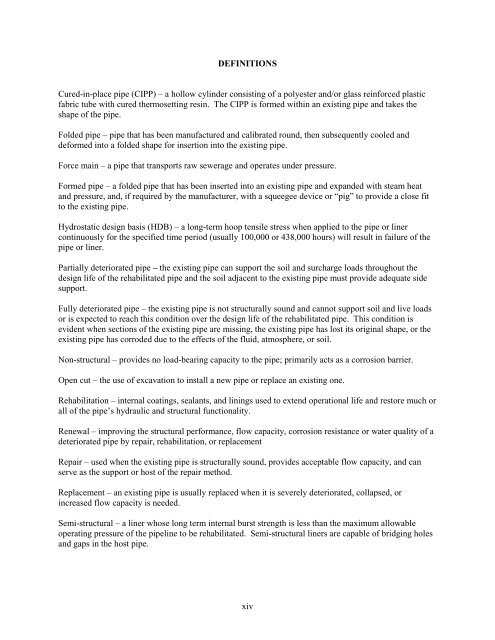State of Technology Report for Force Main Rehabilitation, Final ...
State of Technology Report for Force Main Rehabilitation, Final ...
State of Technology Report for Force Main Rehabilitation, Final ...
Create successful ePaper yourself
Turn your PDF publications into a flip-book with our unique Google optimized e-Paper software.
DEFINITIONS<br />
Cured-in-place pipe (CIPP) – a hollow cylinder consisting <strong>of</strong> a polyester and/or glass rein<strong>for</strong>ced plastic<br />
fabric tube with cured thermosetting resin. The CIPP is <strong>for</strong>med within an existing pipe and takes the<br />
shape <strong>of</strong> the pipe.<br />
Folded pipe – pipe that has been manufactured and calibrated round, then subsequently cooled and<br />
de<strong>for</strong>med into a folded shape <strong>for</strong> insertion into the existing pipe.<br />
<strong>Force</strong> main – a pipe that transports raw sewerage and operates under pressure.<br />
Formed pipe – a folded pipe that has been inserted into an existing pipe and expanded with steam heat<br />
and pressure, and, if required by the manufacturer, with a squeegee device or “pig” to provide a close fit<br />
to the existing pipe.<br />
Hydrostatic design basis (HDB) – a long-term hoop tensile stress when applied to the pipe or liner<br />
continuously <strong>for</strong> the specified time period (usually 100,000 or 438,000 hours) will result in failure <strong>of</strong> the<br />
pipe or liner.<br />
Partially deteriorated pipe – the existing pipe can support the soil and surcharge loads throughout the<br />
design life <strong>of</strong> the rehabilitated pipe and the soil adjacent to the existing pipe must provide adequate side<br />
support.<br />
Fully deteriorated pipe – the existing pipe is not structurally sound and cannot support soil and live loads<br />
or is expected to reach this condition over the design life <strong>of</strong> the rehabilitated pipe. This condition is<br />
evident when sections <strong>of</strong> the existing pipe are missing, the existing pipe has lost its original shape, or the<br />
existing pipe has corroded due to the effects <strong>of</strong> the fluid, atmosphere, or soil.<br />
Non-structural – provides no load-bearing capacity to the pipe; primarily acts as a corrosion barrier.<br />
Open cut – the use <strong>of</strong> excavation to install a new pipe or replace an existing one.<br />
<strong>Rehabilitation</strong> – internal coatings, sealants, and linings used to extend operational life and restore much or<br />
all <strong>of</strong> the pipe’s hydraulic and structural functionality.<br />
Renewal – improving the structural per<strong>for</strong>mance, flow capacity, corrosion resistance or water quality <strong>of</strong> a<br />
deteriorated pipe by repair, rehabilitation, or replacement<br />
Repair – used when the existing pipe is structurally sound, provides acceptable flow capacity, and can<br />
serve as the support or host <strong>of</strong> the repair method.<br />
Replacement – an existing pipe is usually replaced when it is severely deteriorated, collapsed, or<br />
increased flow capacity is needed.<br />
Semi-structural – a liner whose long term internal burst strength is less than the maximum allowable<br />
operating pressure <strong>of</strong> the pipeline to be rehabilitated. Semi-structural liners are capable <strong>of</strong> bridging holes<br />
and gaps in the host pipe.<br />
xiv















